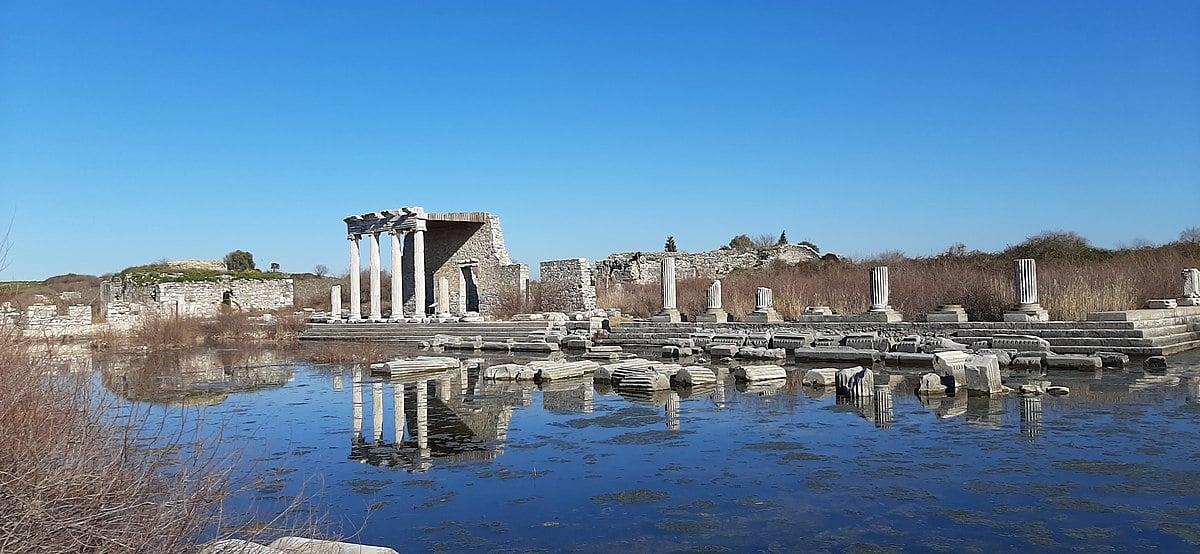
The ruins of an ancient Greek city in Asia Minor have become visible recently for the first time in three decades due to a drought that has caused the water of the Bayramiç Dam to recede.
The ruins belong to Skepsis, an ancient city inhabited by the Greeks and Romans. Archaeologists believe it was first settled in the 6th century BC.
Skepsis was one of many ancient Greek cities (Greek: poleis) in Asia Minor—or what is now modern-day Turkey.
The archaeological site
Çanakkale'deki Bayramiç Barajı'nda su seviyesinin düşmesiyle Skepsis Antik Kenti'ne ait hamam ve kilise kalıntıları 30 yıl sonra tekrar ortaya çıktı. Kaynak: DHA (25.11.2022)#arkeolojihaber #arkeoloji #DahaFazlaArkeoloji pic.twitter.com/r3bEjj0jQD
— arkeolojihaber ® (@arkeolojihaber) November 26, 2022
“The remains of the city that we know as the Ancient City of Skepsis in Bayramiç came to light when the waters of the Bayramiç Dam receded,” said Dr. Oğuz Koçyiğit of the ÇOMÜ Art History Department.
The water recession revealed the ruins of an ancient church and bathhouse that are approximately 1,500 years old. The structures were built during the Roman-Byzantine period, but the city itself dates back to Classical Greek civilization.
“The bath structure is one of the rare structures we know especially in the Byzantine period and is important because of its decorative features, Koçyiğit said. “It gives us information about the architecture, construction techniques, baths and bathing traditions of the period. In this sense, it is important for us that these ruins have come to the surface.”
This is not the first time that the ruins of the ancient city have been examined. Archaeologists Heinrich Schliemann and Frank Calvert also excavated the area in the 19th century. Schliemann and Calvert are famed for their digs at Hisarlik, now believed to be the site of Ilion (Troy).
The ancient Greek city was more recently excavated in the 1990s, but rising waters submerged the ruins. A recent drought in Turkey has exposed them once again.
“Following the rescue excavations carried out here in 1993 and 1995, the bath and church structure were unearthed, documented and surveyed,” Koçyiğit reported. “But unfortunately, the structures were submerged. It is exciting for us to see these structures resurface after 30 years when the waters receded.”
Famous inhabitants of the ancient city
Several notable people hailed from Skepsis. For example, Demetrius of Skepsis was a grammarian who was well-known in the first half of the second century BC for his historical and geographical commentary on the Illiad.
Another inhabitant of the ancient city was Metrodorus. Metrodorus was a philosopher, politician, and teacher of rhetoric. The Greek geographer Strabo commented that Metrodorus was well-known for his written works, which used a” brand-new style and dazzled many.”
Of Metrodorus, Strabo further said that he married a wealthy woman from the Greek polis of Chalcedon. He then came into the service of the Pontic king Mithridates Eupator. However, according to Plutarch, during an embassy to Tigranes the Armenian, Metrodorus fell out of favor with Mithridates and was put to death.
For a time, the written works of Aristotle and Theophrastus were stored in a cellar in Skepsis. Neleus, who was a pupil of Aristotle and a friend of Theophrastus, hid their works to avoid their being taken by Attalus I for his new library in Pergamon.
See all the latest news from Greece and the world at Greekreporter.com. Contact our newsroom to report an update or send your story, photos and videos. Follow GR on Google News and subscribe here to our daily email!



